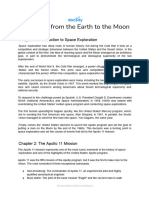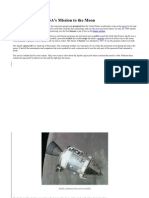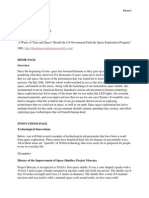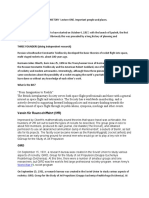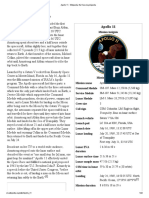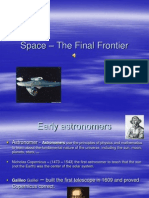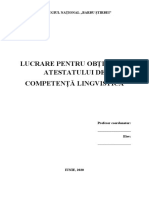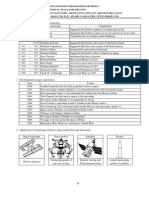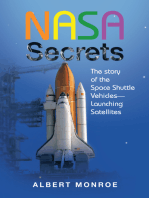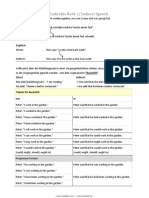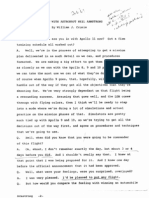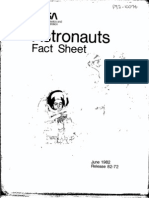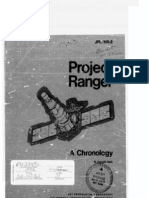Professional Documents
Culture Documents
Leiderman Apollo 8 Training Capsule 2013 10pp
Leiderman Apollo 8 Training Capsule 2013 10pp
Uploaded by
stuart leidermanOriginal Description:
Copyright
Available Formats
Share this document
Did you find this document useful?
Is this content inappropriate?
Report this DocumentCopyright:
Available Formats
Leiderman Apollo 8 Training Capsule 2013 10pp
Leiderman Apollo 8 Training Capsule 2013 10pp
Uploaded by
stuart leidermanCopyright:
Available Formats
STUART M. LEIDERMAN P.O.
Box 1055, Concord, New Hampshire 03302-1055
603.269.2139 [email protected]
Vintage NASA Apollo 8 Training Capsule
Available for Public and Private Use
Leiderman Apollo 8 training capsule, ca. 1968
BACKGROUND: The United States' Apollo 8 was the first flight to the Moon, and occurred during
Christmas Season 1968, more than forty years ago. American astronauts Borman, Lovell and Anders
made ten orbits around the Moon and became the first humans far enough into space to look back and
see the whole Planet Earth. Their color images from space were televised worldwide and seen by
millions of people. Their ship is now displayed at the Museum of Science and Industry in Chicago
In 1994, Stuart Leiderman acquired from Oyster River High School, Durham, New Hampshire, the Apollo 8
capsule used by the U.S. Navy to train for retrieval of the Moon flight upon its return to Earth by ocean
splashdown. This one is full-scale, without cabin or windows, approximately 13 feet in diameter, 10 feet high
and weighs seven tons. It is smoothly welded of thick, alloy steel plates, in twelve sections joined to interior
beams in the fashion of compass points. Large entry hatches are at the side and top. The interior is clear space
and could seat ten. After acquisition, the exterior was power washed and some interior lead ballast disks were
removed; otherwise, it is as acquired, with no modifications. Most of two layers of original paint are evident.
There is very little rust, even after years of exposure. Leiderman has moved the capsule over roadways with a
variety of low-slung tractor trailers, permitted as a wide-load. The original heavy wire cable loop at the top
facilitates lifting the capsule by crane, and it has also been lifted by a wide-bucket front-end loader. The bottom is
dished convexly, where a steel loop holds a length of large towing chain.
OFFERED: The Apollo 8 training capsule is offered with interpretive materials on loan to
cities and towns, organizations and agencies, as a special exhibit item that can be used to
accentuate information, education and action campaigns for human rights, environment
and conservation, public health, artistic expression, conferences and conventions,
sustainable development and other worthy causes.
For display and public participation, fitted fabric collars can be provided, on which
artists and visitors can paint or affix their ideas or greetings according to chosen themes.
The collars would then become souvenirs of the exhibition or, as desired, presented as
gifts, or auctioned to raise money for campaigns and causes.
EVENT EXPENSE CATEGORIES: planning assistance available
1. Capsule: fee negotiable, for the desired period of time.
2. Stuart Leiderman: expertise, travel and expenses for accompaniment, work
w/artists, fundraising, lectures, appearances, conference other event fees.
3. Transport: motor, rail or ship, round trip from New Hampshire, USA
4. Insurance: premium on $1 million policy for duration of transport and use.
5. Display stand or trailer: user purchased, rented or built as needed.
6. Outfitting, supplies: collars, interior, exterior, display, as desired by user.
7. Available artistic talent: commission or stipend, as desired by user
8. Other staffing, public relations: as desired by user
9. Available video-documentary service: promotion and post-event products.
pictured, the NASA Apollo 8 that went
to the moon is in the Chicago Museum
of Science and Technology
STUART M. LEIDERMAN
P.O. Box 1055, Concord, New Hampshire 03302-1055
603.269.2139 [email protected]
STUART M. LEIDERMAN
P.O. Box 1055, Concord, New Hampshire 03302-1055
603.269.2139 [email protected]
STUART M. LEIDERMAN
P.O. Box 1055, Concord, New Hampshire 03302-1055
603.269.2139 [email protected]
http://www.hq.nasa.gov/office/pao/History/SP-4009/v4p3b.htm December 21-27, 1968
MSC, "Apollo 8 Mission Report," Feb. 1969, pp. 1-1, 1-2; NASA OMSF, "Apollo Program Flight Summary Report,
Apollo Missions AS-201 through Apollo 8," Jan. 1969, pp. 32-35; Astronautics and Aeronautics, 1968, (NASA
SP-4010, 1969), pp. 318-23.
Apollo 8 (AS-503) was launched from KSC Launch Complex 39, Pad A, at 7:51 a.m. EST Dec. 21 on a Saturn V
booster. The spacecraft crew was made up of Frank Borman, James A. Lovell, Jr., and William A. Anders. Apollo 8
was the first spacecraft to be launched by a Saturn V with a crew on board, and that crew became the first men to
fly around the moon.
All launch and boost phases were normal and the spacecraft with the S-IVB stage was inserted into an
earth-parking orbit of 190.6 by 183.2 kilometers above the earth. After post-insertion checkout of spacecraft
systems, the S-IVB stage was reignited and burned 5 minutes 9 seconds to place the spacecraft and stage in a
trajectory toward the moon - and the Apollo 8 crew became the first men to leave the earth's gravitational field.
The spacecraft separated from the S-IVB 3 hours 20 minutes after launch and made two separation maneuvers
using the SM's reaction control system. Eleven hours after liftoff, the first midcourse correction increased velocity
by 26.4 kilometers per hour. The coast phase was devoted to navigation sightings, two television transmissions,
and system checks. The second midcourse correction, about 61 hours into the flight, changed velocity by 1.5
kilometers per hour.
The 4-minute 15-second lunar-orbit-insertion maneuver was made 69 hours after launch, placing the spacecraft
in an initial lunar orbit of 310.6 by 111.2 kilometers from the moon's surface - later circularized to 112.4 by
110.6 kilometers. During the lunar coast phase the crew made numerous landing-site and landmark sightings,
took lunar photos, and prepared for the later maneuver to enter the trajectory back to the earth.
On the fourth day, Christmas Eve, communications were interrupted as Apollo 8 passed behind the moon, and the
astronauts became the first men to see the moon's far side. Later that day , during the evening hours in the United
States, the crew read the first 10 verses of Genesis on television to earth and wished viewers "goodnight, good
luck, a Merry Christmas and God bless all of you - all of you on the good earth."
Subsequently, TV Guide for May 10-16, 1969, claimed that one out of every four persons on earth - nearly 1
billion people in 64 countries - heard the astronauts' reading and greeting, either on radio or on TV; and delayed
broadcasts that same day reached 30 additional countries.
On Christmas Day, while the spacecraft was completing its 10th revolution of the moon, the service propulsion
system engine was fired for three minutes 24 seconds, increasing the velocity by 3,875 km per hr and propelling
Apollo 8 back toward the earth, after 20 hours 11 minutes in lunar orbit. More television was sent to earth on the
way back and, on the sixth day, the crew prepared for reentry and the SM separated from the CM on schedule.
Parachute deployment and other reentry events were normal. The Apollo 8 CM splashed down in the Pacific, apex
down, at 10:51 a.m. EST, December 27 - 147 hours and 42 seconds after liftoff. As planned, helicopters and
aircraft hovered over the spacecraft and pararescue personnel were not deployed until local sunrise, 50 minutes
after splashdown. The crew was picked up and reached the recovery ship U.S.S. Yorktown at 12:20 p.m. EST. All
mission objectives and detailed test objectives were achieved, as well as five that were not originally planned (see
Appendix 5). The crew was in excellent condition, and another major step toward the first lunar landing had been
accomplished.
You might also like
- NASA - Atestat EnglezaDocument15 pagesNASA - Atestat EnglezaSava100% (3)
- Moon Shot: The Inside Story of America's Apollo Moon LandingsFrom EverandMoon Shot: The Inside Story of America's Apollo Moon LandingsRating: 3.5 out of 5 stars3.5/5 (15)
- Apollo Operations Handbook CSM Spacecraft 012Document1,010 pagesApollo Operations Handbook CSM Spacecraft 012Bob Andrepont100% (9)
- Apollo Program Research PaperDocument4 pagesApollo Program Research Papergvzcrpym100% (1)
- Newsletter JulyDocument2 pagesNewsletter Julyapi-610394285Noch keine Bewertungen
- Apollo 11 5th Anniversary Press KitDocument86 pagesApollo 11 5th Anniversary Press KitBob AndrepontNoch keine Bewertungen
- Space Exploration TimelineDocument26 pagesSpace Exploration TimelineKristine BarredoNoch keine Bewertungen
- The Apollo ProgramDocument2 pagesThe Apollo ProgramaltaxtianNoch keine Bewertungen
- Chariots for Apollo: The NASA History of Manned Lunar Spacecraft to 1969From EverandChariots for Apollo: The NASA History of Manned Lunar Spacecraft to 1969Rating: 4.5 out of 5 stars4.5/5 (5)
- Domenicolauria FinaldraftofresearchpaperDocument4 pagesDomenicolauria Finaldraftofresearchpaperapi-358495277Noch keine Bewertungen
- Try AI On One of Our Notes Take Off Like Apollo 11Document16 pagesTry AI On One of Our Notes Take Off Like Apollo 11yordaniymami19911012Noch keine Bewertungen
- Seminar Report OnDocument32 pagesSeminar Report OnVijay SinghNoch keine Bewertungen
- John F. Kennedy MoonDocument9 pagesJohn F. Kennedy MoonChakrapal VermaNoch keine Bewertungen
- Lunar ExplorationDocument3 pagesLunar ExplorationBandar AlmutairiNoch keine Bewertungen
- Space Exploration TimelineDocument34 pagesSpace Exploration TimelineKate Racel CalimlimNoch keine Bewertungen
- The Apollo 11 Moon Landing: A Day That Changed AmericaFrom EverandThe Apollo 11 Moon Landing: A Day That Changed AmericaNoch keine Bewertungen
- NASA Langley Research Center's Contributions To The Apollo ProgramDocument10 pagesNASA Langley Research Center's Contributions To The Apollo ProgramBob AndrepontNoch keine Bewertungen
- ReadingDocument18 pagesReadingHamza ŞahinNoch keine Bewertungen
- Broadcast: 28 July 2009Document6 pagesBroadcast: 28 July 2009Anthony Saavedra AbarulloNoch keine Bewertungen
- Introduction To The Space AgeDocument16 pagesIntroduction To The Space AgeAnne MillbrookeNoch keine Bewertungen
- Apollo 14 - Science at Fra MauroDocument50 pagesApollo 14 - Science at Fra MauroBob Andrepont100% (1)
- Where No Man Has Gone BeforeDocument430 pagesWhere No Man Has Gone BeforeBob Andrepont75% (4)
- Apollo ProgramDocument47 pagesApollo ProgramAnonymous 4FVm26mbcONoch keine Bewertungen
- Space Flight Missions HistoryDocument104 pagesSpace Flight Missions HistoryAviation/Space History Library100% (3)
- Space Race PDFDocument3 pagesSpace Race PDFNiuerb BeibreNoch keine Bewertungen
- Science PBL: Space Exploration: Name: Muhamad Hadi Syahputra Bin Ramdzan Ali Class: 3aviorDocument18 pagesScience PBL: Space Exploration: Name: Muhamad Hadi Syahputra Bin Ramdzan Ali Class: 3aviorMUHAMAD HADI SYAHPUTRA BIN RAMDZAN ALI MoeNoch keine Bewertungen
- NASA: 70822main FS-1996-12-25-LaRCDocument10 pagesNASA: 70822main FS-1996-12-25-LaRCNASAdocumentsNoch keine Bewertungen
- Revised Final DraftDocument6 pagesRevised Final Draftapi-300294333Noch keine Bewertungen
- Milestones of Space: Eleven Iconic Objects for the Smithsonian National Air and Space MuseumFrom EverandMilestones of Space: Eleven Iconic Objects for the Smithsonian National Air and Space MuseumRating: 3 out of 5 stars3/5 (1)
- Apollo 13 ThesisDocument5 pagesApollo 13 Thesisgjcezfg9100% (2)
- Space Exploration History Lecture OneDocument10 pagesSpace Exploration History Lecture OneKiran RajuNoch keine Bewertungen
- The Launch of Sputnik, 1957Document10 pagesThe Launch of Sputnik, 1957Wojtek BonkNoch keine Bewertungen
- Activity 3 StsDocument19 pagesActivity 3 Stsolasiman.erickajane.tNoch keine Bewertungen
- Foundational Human Spaceflight: Main ArticleDocument6 pagesFoundational Human Spaceflight: Main ArticleSharmila KNoch keine Bewertungen
- Apollo 11 - Wikipedia, The Free EncyclopediaDocument12 pagesApollo 11 - Wikipedia, The Free EncyclopediaAnonymous iATfY8o5xNoch keine Bewertungen
- Space - The Final FrontierDocument51 pagesSpace - The Final FrontierAbdul Shakoor100% (1)
- Essayonthespacerace AaronDocument3 pagesEssayonthespacerace Aaronapi-300081925Noch keine Bewertungen
- Apollo 11 First Steps Marketing & Educational GuideDocument62 pagesApollo 11 First Steps Marketing & Educational GuideSohelPatel Sohel PatelNoch keine Bewertungen
- Analysis & Simulation of The Trajectory of The Apollo 11 Flight To MoonDocument57 pagesAnalysis & Simulation of The Trajectory of The Apollo 11 Flight To MoonThomas W KotowskiNoch keine Bewertungen
- Neil Armstrong : The First Man to Walk on the Moon - Biography for Kids 9-12 | Children's Biography BooksFrom EverandNeil Armstrong : The First Man to Walk on the Moon - Biography for Kids 9-12 | Children's Biography BooksNoch keine Bewertungen
- Atestat de Competenta Lingvistica - MODELDocument18 pagesAtestat de Competenta Lingvistica - MODELBogdan StefanNoch keine Bewertungen
- History Speech PDFDocument2 pagesHistory Speech PDFYash NanayakkaraNoch keine Bewertungen
- Moon Race 1Document15 pagesMoon Race 1api-252868030Noch keine Bewertungen
- English Reasearch Paper (YOUSUF)Document7 pagesEnglish Reasearch Paper (YOUSUF)webking2006Noch keine Bewertungen
- F3 Chapter 10 - Space ExplorationDocument1 pageF3 Chapter 10 - Space ExplorationNasruddin Amir100% (1)
- Apollo 16 Scientific Investigation of The MoonDocument12 pagesApollo 16 Scientific Investigation of The MoonBob Andrepont100% (1)
- America in Space The First Five Years - A Pictorial ReviewDocument76 pagesAmerica in Space The First Five Years - A Pictorial ReviewBob Andrepont100% (2)
- Satellite: Early ConceptionsDocument5 pagesSatellite: Early Conceptionsax33m144100% (1)
- Summary of Challenger by Adam Higginbotham: A True Story of Heroism and Disaster on the Edge of SpaceFrom EverandSummary of Challenger by Adam Higginbotham: A True Story of Heroism and Disaster on the Edge of SpaceNoch keine Bewertungen
- A Student Guide To The Principles of SpaceDocument20 pagesA Student Guide To The Principles of Spaceapi-3827338Noch keine Bewertungen
- SPace ExplorationDocument1 pageSPace ExplorationBaže PalitovNoch keine Bewertungen
- Apollo 11 - Simple English Wikipedia, The Free EncyclopediaDocument25 pagesApollo 11 - Simple English Wikipedia, The Free EncyclopediaafpronkpaNoch keine Bewertungen
- Nasa Secrets the Story of the Space Shuttle Vehicles— Launching SatellitesFrom EverandNasa Secrets the Story of the Space Shuttle Vehicles— Launching SatellitesNoch keine Bewertungen
- Ringmakers of Saturn by Norman R. BergrunDocument149 pagesRingmakers of Saturn by Norman R. BergrunPEDRONoch keine Bewertungen
- Living and Working in Space: The NASA History of SkylabFrom EverandLiving and Working in Space: The NASA History of SkylabRating: 4.5 out of 5 stars4.5/5 (2)
- Apollo 13 ThesisDocument5 pagesApollo 13 Thesisgjcezfg9100% (2)
- What Are Wind TunnelsDocument4 pagesWhat Are Wind Tunnelsalmario_camusNoch keine Bewertungen
- T SC 2550015 Apollo 13 LKS2 Reading Comprehension Ver 5Document18 pagesT SC 2550015 Apollo 13 LKS2 Reading Comprehension Ver 5Global Investment HoldingNoch keine Bewertungen
- NASA: 83143main 1991Document184 pagesNASA: 83143main 1991NASAdocumentsNoch keine Bewertungen
- Leadership and Change at NASA: Sean O'Keefe As AdministratorDocument11 pagesLeadership and Change at NASA: Sean O'Keefe As AdministratorMutati TNoch keine Bewertungen
- Nasa Facts STS-102Document3 pagesNasa Facts STS-102Bob AndrepontNoch keine Bewertungen
- Back To Earth Non-Chronological Report Differentiated Reading Comprehension ActivityDocument11 pagesBack To Earth Non-Chronological Report Differentiated Reading Comprehension ActivityFatma HeshamNoch keine Bewertungen
- DSN Mission Contact ListDocument4 pagesDSN Mission Contact ListElevers WorldNoch keine Bewertungen
- SpaceX PresentationDocument12 pagesSpaceX Presentationyassine.nafraoui16Noch keine Bewertungen
- NASA Facts John F. Kennedy Space CenterDocument8 pagesNASA Facts John F. Kennedy Space CenterBob AndrepontNoch keine Bewertungen
- Indirekt SpeechDocument5 pagesIndirekt Speechdali68Noch keine Bewertungen
- OMEGA Speedmaster - First Watch On The MoonDocument2 pagesOMEGA Speedmaster - First Watch On The MoonVinNoch keine Bewertungen
- Unit 7 Grammar Help: Zero Conditional - First Conditional Third ConditionalDocument1 pageUnit 7 Grammar Help: Zero Conditional - First Conditional Third ConditionalRamos Castro Karla JohanaNoch keine Bewertungen
- Đề Chính Thức: SECOND END-TERM TEST (2019-2020)Document3 pagesĐề Chính Thức: SECOND END-TERM TEST (2019-2020)Phương VũNoch keine Bewertungen
- IAC 19, A3,1,2, x52841Document13 pagesIAC 19, A3,1,2, x52841pacoNoch keine Bewertungen
- Neil Armstrong Interview (1969)Document8 pagesNeil Armstrong Interview (1969)Aviation/Space History LibraryNoch keine Bewertungen
- Some of The Famous Filipino PhysicistDocument5 pagesSome of The Famous Filipino PhysicistVichelle Feliszza Bacalian67% (3)
- Astronauts Fact Sheet June 1982Document28 pagesAstronauts Fact Sheet June 1982Bob AndrepontNoch keine Bewertungen
- JASKARAN KAURnone - Exp22 - Word - Ch02 - CumulativeAssessment - SpaceDocument2 pagesJASKARAN KAURnone - Exp22 - Word - Ch02 - CumulativeAssessment - SpaceTARUNJOT SINGHNoch keine Bewertungen
- Project Ranger A ChronologyDocument596 pagesProject Ranger A ChronologyBob AndrepontNoch keine Bewertungen
- Nugroho Syahputra - TOEFL Exercise 6 (Where Questions)Document6 pagesNugroho Syahputra - TOEFL Exercise 6 (Where Questions)NET BINARYNoch keine Bewertungen
- Gemini 4 PAO TranscriptDocument447 pagesGemini 4 PAO TranscriptBob AndrepontNoch keine Bewertungen
- Space RaceDocument18 pagesSpace Raceapi-392542935Noch keine Bewertungen
- The Giver Essay TopicsDocument7 pagesThe Giver Essay Topicsfesegizipej2100% (2)
- Subiecte 8Document4 pagesSubiecte 8Mario TescanNoch keine Bewertungen
- Crawler TransportersDocument4 pagesCrawler TransportersJjnebeNoch keine Bewertungen
- Math Whiz Katherine Johnson: Grade 5 Reading ComprehensionDocument2 pagesMath Whiz Katherine Johnson: Grade 5 Reading ComprehensionAriel DulvaNoch keine Bewertungen
- NASA Facts STS-103Document2 pagesNASA Facts STS-103Bob AndrepontNoch keine Bewertungen
- NASA: 83130main 1978Document146 pagesNASA: 83130main 1978NASAdocumentsNoch keine Bewertungen













